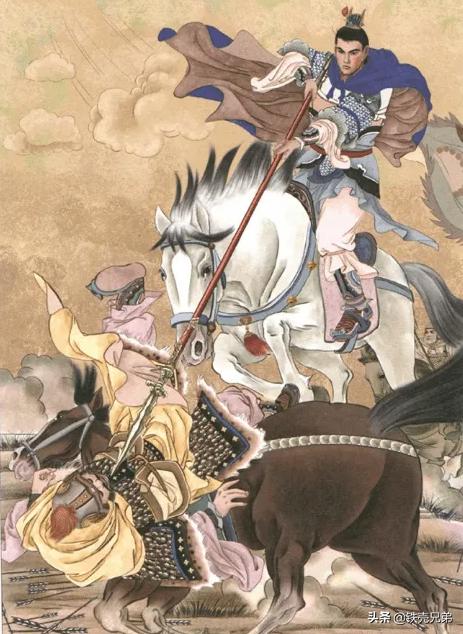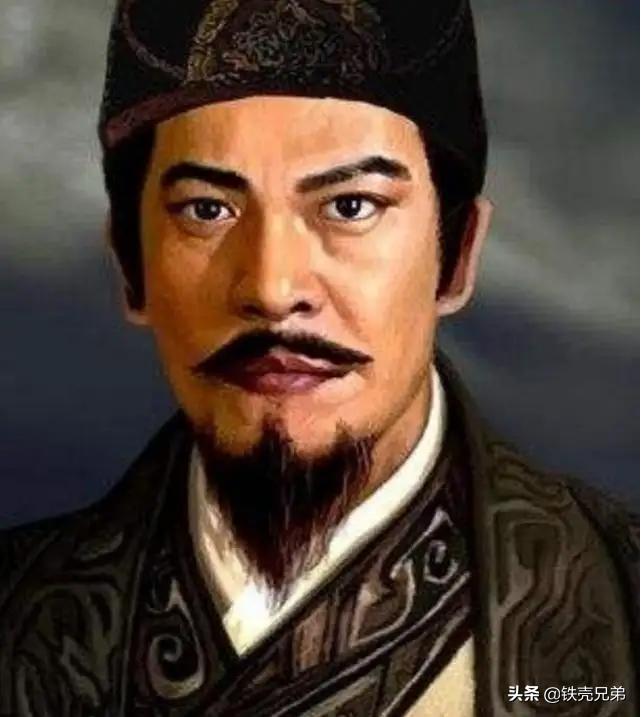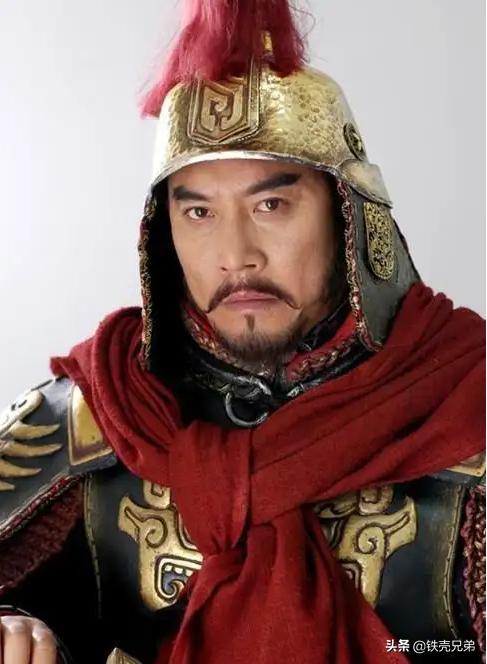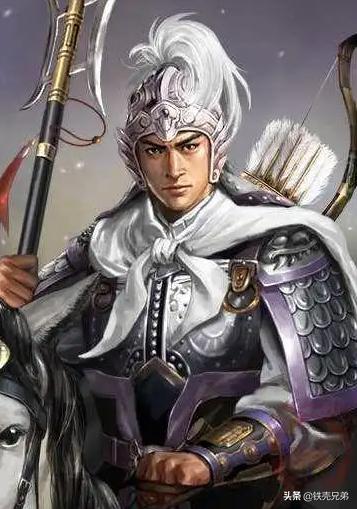The four famous generals of the Tang Dynasty, Li Jing, Su Dingfang, Li Ji, and Xue Rengui, all had good reputations. At the same time, they all lived long and died well.
In the twenty-third year of Zhenguan (649), Li Jing died of illness at the age of seventy-nine. In the second year of Qianfeng (667), Su Dingfang died at the age of seventy-six (one for sixty-seven). In the second year of Zongzhang (669), Li Ji died at the age of seventy-six. In the second year of Yongchun (683), Xue Rengui died at the age of seventy.

Both Su Dingfang and Li Ji died at the age of 76. Li Jing is the oldest at 79 years old, and Xue Rengui is the youngest at 70 years old. But they all live long, and they all end well. The reputation is also good.
Let's talk about Li Jing, the most powerful god of war:
Li Jing entered the shogunate of King Li Shimin of Qin in his early years, and then went on a campaign. In the second year of Wude (619), he entered Shu to assist Li Xiaogong, the king of Zhao Jun, in planning to eliminate Xiao Xian , the separatist force in the south . In March of the following year (620), he defeated the rebel army of Ran Zhao, the leader of the rebels in Kaizhou ( now Kaixian, Sichuan ). In the first month of the fourth year of Wude (621), he offered Li Xiaogong ten strategies to help him rule the twelve commanders. With merit, he was awarded the Lingnan Dao consolation ambassador and the supervisor of Guizhou, so he traveled to Guizhou ( now Guilin , Guangxi ) and recruited the ninety-six prefectures in Lingnan. In the sixth year of Wude (623), he assisted Li Xiaogong in commanding the Seven Commanders to suppress the Fugong Yi army against the Tang Dynasty , and captured and beheaded Fu Gong Yi. In the eighth year of Wude (625), when the Turks attacked Taiyuan, Li Jing, as the marching general manager, commanded 10,000 troops to station in Taigu ( now Shanxi ). In April of the following year (626), Xia Shi repelled the attack of the Eastern Turkic Jieli Khan in Lingzhou, present-day southwest of Lingwu, Ningxia . In November of the third year of Zhenguan (629), he was appointed as the marching general of Dingxiang Road, and ordered the six generals including Li Ji, the governor of Jiedu and Bingzhou, to fight back against the Turks. The territory of the Tang Dynasty was greatly expanded, from the north of Yinshan to the desert, and the north was stable. In the ninth year of Zhenguan (635), when Tuyuhun invaded, Li Jing asked himself to send troops, and he led Hou Jun, Li Daozong , and other five generals to march west, and quelled the Tuyuhun rebellion in the following year (636).
Let's take a look at Su Dingfang, who destroyed the Three Kingdoms Rebellion:
Su Dingfang galloped the battlefield for decades, attacking Jieli in the north, destroying the Turks in the west, flattening Baekje in the east, and suppressing Tubo in the south. In the 289th year of the founding of the Tang Dynasty, its vast territory reached the peak of the Gaozong Dynasty, and the prestige of the Tang Dynasty spread to the northwest corners and the eastern states, which not only laid the foundation for the stability and prosperity of the Central Plains, but also promoted The economic and cultural exchanges of various ethnic groups have made important contributions to the formation of the current Chinese territory.
Su Dingfang is not only heroic but also upright. When Wang Wendu killed and surrendered to seek fortune, "only Dingfang took nothing"; after the demise of the Western Turks, Su Dingfang asked "all the tribes to return to their homes, access roads, set up post offices, cover up skeletons, ask sufferings, draw battlefields, In the rebirth industry, all those who were taken by Shabala will be returned, and the ten surnames will remain as they were.” When Duman surrendered, Su Dingfang had promised to spare his life. In order to keep his promise, he immediately begged Tang Gaozong to save his death penalty to preserve his faith. . In the last days of his life, Su Dingfang was still at the forefront of the Tuyuhun battlefield in his seventies.

When Su Dingfang was young, he followed his father Su Yong to crusade against thieves in the prefectures and counties . Li Shi, a Qing Dynasty man, praised Su Dingfang as "a role model for those who were trained in the village by the time group"
In the fourth year (630) of Emperor Taizong 's reign in Tang Dynasty, Su Dingfang followed Li Jing , the general manager of the Dingxiang Road march, to attack the Eastern Turkic Jieli Khan . He led 200 cavalry to attack the tent (the camp where the generals lived), forcing the khan of Jieli to flee. Li Jing then arrived with a large army and defeated the Eastern Turks. Jieli Khan was also captured by the Tang army, and the Eastern Turks were destroyed. In the sixth year of Yonghui (655), Su Dingfang accompanied Cheng Zhijie (namely Cheng Yaojin), the chief general of the army on the Cong Mountain Road, to conquer the Western Turks . During the battle of Yingsuochuan (now the Yuledus Valley in the upper reaches of the Kaidu River in Xinjiang) the following year, he led 500 cavalry directly to the Western Turkic barracks, chasing more than 1,500 people. In the second year of Xianqing (657), Su Dingfang once again went to attack the Western Turkic Shabala Khan Ashnahoru , fighting with more than 10,000 Western Turkic troops, beheading tens of thousands of Turkic troops and killing their chiefs. There were two hundred people waiting for Dagan. Afterwards, they traveled on the snow and attacked Jinya Mountain (to the west of today's Tokemak, Kyrgyzstan ), and defeated Helu again. He Lu led the remnants to flee and was captured by Su Dingfang's deputy general Xiao Siye . After the troops were relieved, Su Dingfang appeased the tribes of the Western Turks, opened a way to set up a post, consoled the suffering, and resumed production, so that the tribes of the ten surnames were blocked as before. After the demise of the Western Turks, the Central Asian countries also surrendered to the Tang Dynasty.
In the fourth year of Xianqing (659), Su Dingfang defeated Dayanmangbuzhi, deputy prime minister of Tubo, in Wuhai . In the third year of Longshuo (663), Su Dingfang served as the ambassador of Anji, " Jiedu the army", as a backup for Tuyuhun who was expelled by Tubo .
In the fourth year of Xianqing (659), Sijie Que and Jin Duman together with Shule (now in the area of Kashgar in southwestern Xinjiang), Zhu Jubo (in the area of Yecheng in today's southwestern Xinjiang ), Hubantuo (also known as Congling Country) , today's Tashkurgan area in southwestern Xinjiang ) and other three countries rebelled, and Su Dingfang was ordered to lead the westward expedition. After he arrived at Ye Yeshui (now the Syr Darya RiverUzbekistan and Tajikistan ), he selected elite soldiers and forcibly marched for 300 li to raid the Duman army. They pressed Ma Baocheng again, and finally forced Duman Kaicheng to surrender. So far, the western territory of the Tang Dynasty reached the Aral Sea (the Caspian Sea ), reaching the extreme .
In the fifth year of Xianqing (660), Su Dingfang was appointed as the chief of the march of Shenqiu Road, and led an army of 100,000 people on land and water to conquer Baekje . The Tang army crossed the Yellow Sea and reached the mouth of the Xiongjin River (now the mouth of the Jinjiang River in the south of the Korean Peninsula ), defeating Baekje. Su Dingfang rode up the tide , led his foot and cavalry to join the river, and approached Sibao City ( now Fuyu County, South Chungcheong Province, South Korea). The whole city of Baekje was dispatched and defeated by the Tang army. Afterwards, Baekje King Fuyu Yici and Prince Fuyu Long surrendered and Baekje perished. The attack and destruction of Baekje in the Tang Dynasty was a rare cross-sea amphibious operation in the history of ancient Chinese warfare , reflecting the strong naval construction and advanced navigation and shipbuilding technology in the early Tang Dynasty. This campaign enabled the Tang Dynasty to use the homeland of Baekje as a strategic stronghold to form a north-south attack on Goryeo, laying a solid foundation for the final demise of Goryeo.
In the fifth year of Xianqing (660), Su Dingfang took the position of the marching chief of Liaodong Road and Qi Bi Heli, the chief marching chief of Wujiang Road , to attack Goryeo. The following year, Su Dingfang was transferred to the commander-in-chief of Pyongyang, and instead, he joined Qi Bi He Li and Ren Ya Xiang to lead the army to attack Korea. In August, Su Dingfang defeated the Goryeo army in the Yujiang River (now the Datong River in North Korea) and entered the siege of Pyongyang City (the capital of Goguryeo). However, due to factors such as the return of the Tang army on the North Road, the cold climate of Goryeo, and the inability of Silla to provide support as scheduled, Su Dingfang had no choice but to train in February of the second year of Longshuo (662).
Let's take a look at Li Ji, who is also called Li Jing , Duke Wei :
Wagang Army Period : Li Ji joined Zhai Rang's Wagang Army ( now southeast of Huaxian County, Henan Province ) in the last year of Emperor Yang's Great Ye (605-618) of Sui Dynasty . He persuaded Zhai Rang to snatch the canal property. When Wang Shichong led the army to crusade against Li Mi, Li Ji defeated Wang Shichong many times with odd tactics. He also suggested that Li Mi should attack Li Yangcang, so that the Wagang army would be greatly strengthened. When guarding Li Yangcang, he attacked Yu Wenhua, who was besieging the city, and forced him to escape.
Tang Emperor Gaozu Period : In the second year of Wude (619), Li Ji returned to the Tang Dynasty with Li Mi's territory, and was still the chief administrator of Li Yang. After being captured by Dou Jiande, Li Ji attempted to attack Dou Jiande and murder Dou Jiande's general Cao Dan. From the third year of Wude (620) to the seventh year of Wude (624), Li Ji, along with King Li Shimin of Qin, defeated Song Jingang, captured Dou Jiande, pacified Wang Shichong, defeated Liu Heida and Xu Yuanlang and others. Together with Li Xiaogong, the king of Zhao County, and Li Jing, the ambassador of Lingnan Road, they captured Fu Gongyi and pacified Jiangnan. In the eighth year of Wude (625), the Turks invaded Bingzhou, and Li Ji led the army to resist.

Tang Taizong period : In the third year of Zhenguan (629), Li Ji and Li Jing led an army of more than 100,000 troops to attack the Eastern Turks. The following year, Li Jing defeated the Eastern Turkic Jieli Khan in the Battle of Yinshan. After Jieli Khan was defeated, he was blocked by Li Ji and could not escape north. Li Ji finally captured more than 50,000 East Turkic troops and returned to the division. From the ninth year of Wude (626) to the fifteenth year of Zhenguan (641), Li Ji was in Bingzhou, and he was quite competent. In the fifteenth year of Zhenguan (641), Li Ji defeated Xue Yantuo's army in Nuozhenshui ( in present-day Ulanqab City, Inner Mongolia ), beheading more than 3,000 grades, and captured more than 50,000 people and 15,000 horses. In the nineteenth year of Zhenguan (645), Li Ji was ordered to attack Gaoli, and even broke Gaimu (now Fushun, Liaoning), Liaodong (now the northeast corner of the old city of Liaoyang in Liaoyang City), Baiyan (now Xiuyan, Liaoning Province) and other cities, and participated in the attack.The battle of( now Yingchengzi, southeast of Haicheng, Liaoning ). The following year, Li Ji took advantage of Xue Yantuo's civil strife toappease Yitewushou Khan Dumozhi and others on Yudujun Mountain ( also known as Wudenan Mountain, which is now the Shandong branch of Hangai in Mongolia ). He also sent troops to destroy the remnants of Xue Yantuo, completely destroying the Xue Yantuo regime.
Tang Gaozong period : in the first year of Qianfeng (666 years), Li Ji served as the general manager of the Liaodong Road march and set off again to go to Korea. In the following year, Li Ji led his army forward and took Xincheng (north of Xinbin Manchu Autonomous County, Liaoning Province), Nansu (now the interchange between East Suzi River and Hunhe River in Fushun, Liaoning Province), Mudi (now Ximuqi Town, Xinbin, Liaoning Province), Cang. Yan (now Ji'an, Ji'an West), Fuyu (now Siping, Liaoning), Chenyi and other cities. And together with Qi Bi He Li and other ministries encircled Pyongyang. In September, the Tang army conquered Pyongyang and Koguryo was destroyed.
Finally, look at the white robe teenager Xue Rengui:
Xue Rengui joined the army at the end of Emperor Taizong 's Zhengguan (627-649) years and defeated Goryeo in Anshicheng (now Yingchengzi, southeast of Haicheng, Liaoning). In the third year of Xianqing (658), the Koryo army was defeated again in Guiduan City (located in the area of Hunhe River in today's Liaoning Province). The following year, he fought with Goryeo general Onsamon in Yokosan, Shiseong and other places. In December, he defeated the Khitan in Montenegro and captured the Khitan King Abgu. In the first year of Longshuo (661), he defeated the nine surnames Tiele. In the first year of Qianfeng (666), he participated in the destruction of Goryeo . In the first year of Yongchun (682), he defeated the Turks in the Battle of Yunzhou .

In terms of seniority, Xue Rengui should be the least senior among the four. Xue Rengui served as a subordinate to Su Dingfang and Li Ji.
In terms of record, Su Dingfang can compete with Li Jing. Li Ji is next, Xue Rengui's record is also good, but Xue Rengui is the only one of the 4 who has a losing record.
To pacify the Turks with the strategy of one person, Tuyuhun chaos. He is the only commander out of the 4 who actually has a military book.
Li Jing has written excellent military works based on his life's practical experience, which can only be found in "Old Tang Books, Classics and Books" and " New Tang Books, Yiwenzhi" . Volumes, "Jade Accounts Classic" 1 volume, "Baguo Proverbs" 1 volume, " Song History·Yiwenzhi " also recorded "Taoqian Secretary" 1 volume, "Taoqian General Essentials" 3 volumes, "Records of Duke Wei Guogong" "Volume 1, "New Book of Soldiers", Volume 1 and "Gong Jue", etc., many of which have been lost so far. Today's handed down " Tang Taizong Li Wei Gong Wen Du " (or " Li Wei Gong Wen Du ") was included in the " Seven Books of Wujing " during the Northern Song Dynasty , or it was written by Song people, and the name of Li Jing was misappropriated, which is not enough. The original book is " Li Wei Gong's Art of War ", the original book is lost today, but from the "General Wei's Art of War" scattered in Du You 's "Tong Dian · Bing Dian" and "Taiping Yu Lan · Ministry of War ", you can still see the leopard in the tube, about Li Jing's army management, There are records of marching battles, camping scouts, etc.
Li Jing was both civil and military, brave and good at fighting, and made great achievements for the unification and consolidation of the Tang Dynasty. At the same time, he has accumulated a set of successful experiences in general and combat operations, and further enriched and developed China's military thought and theory.
1. Emphasis on being prepared to deal with sudden events : Li Jing believes that only by being prepared for peacetime can we be invincible in an emergency situation. He said: "If the soldiers are not prepared in advance, they should not be killed. If they are not ready, they will lose the opportunity. If they lose the opportunity, they will be later.
2. Emphasis on planning first and then fighting : Li Jing pointed out: "The strategy of decisive victory is to investigate the ability of the generals, to judge the strength of the enemy, to cut off the situation of the ground, to observe the appropriateness of the time, to win first, then to fight, and to defend the ground. It is the way to win without losing." If you fight for the generals without a plan, it is no different from "driving the common people to go to soup and fire, driving cattle and sheep to eat wolves and tigers".
3. Emphasize that the appropriateness of offense and defense depends on circumstances : Regarding the two basic combat types of offense and defense, Li Jing not only used the assertion that “offensive is an opportunity for defense, defense is a strategy for offense, and both are the result of victory” to reveal both offense and defense. On the contrary, the dialectical relationship complements each other, and further clarifies the truth that the appropriateness of offense and defense depends on circumstances, and expounds the strategic thought of "lasting defense". He said, "Although the love of the soldiers is mainly speed, it is not enough to take advantage of others", but when "the enemy generals are resourceful, the army and soldiers are in harmony, the orders are prohibited, the soldiers are sharp and four strong, the spirit is sharp and strict, and the strength is full and vigorous." Then when the traces hide the sound, store up the surplus and wait to be exhausted, avoid its edge, and it lasts forever.”
4. Emphasizing the need to be good at using the technique of "qizheng phase transition" : Based on the war experience at that time, Li Jing made a systematic and dialectical exposition of Qizheng from the combination of theory and practice, revealing that "qizheng phase transition" is a The essence of "Qizheng" theory. He believes that generals who can only use the right and not the odd, or only use the odd but not the right are not the best generals. Only those who "get everything right" are the good generals who help the country. In order to "get everything right", the key is to be good at using the technique of "phase transformation" in war practice. For this reason, he emphasized that in the application of tactics, we must use the method of "showing the form" to detect the enemy's real situation and make "temporary changes" according to the specific situation; in the deployment of troops, we must proceed from the actual situation of the enemy and achieve appropriate division , Qi is right. In the practice of war, as long as we are good at using the technique of "transformation of the strange and the righteous", and "nothing is wrong, nothing is strange, and the enemy is unpredictable", the combat purpose of "the right is also victorious, and the odd is also victorious" can be achieved.
These theories had some influence on the battles of the next three, Su Dingfang, Xue Rengui, and Li Ji.